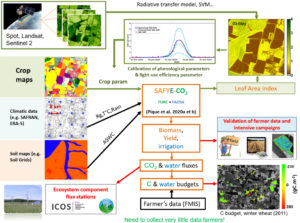The SAFYE-CO2 model (Veloso, 2014 ; Pique et al., 2020 a & b) is an agro-meteorological model that allows spatialized estimation of field crop’s soil evaporation, transpiration and carbon budget components : biomass production, yield, photosynthesis, plant & soil respiration, net CO2 flux . As the model is driven by high resolution satellite data, it can be applied at landscape level at high resolution (e.g. 10 m which is the resolution of Sentinel-2 satellite data) or at plot scale.
Due to the computation time involved in the satellite data assimilation method (iterative inversion based on the minimization of the difference between simulated and observed Leaf Area Index (LAI), simulations at the pixel scale are only performed for validation of the model’s outputs vs. in-situ data acquired over an area equivalent to the pixel for biomass and yield variables. For validation of the CO2 and water fluxes, the model is applied at the plot level and data are compared with flux tower measurements. For the production of landscape/small area scale maps the model is applied at plot level.
The model operates at a daily time step (Figure 1) and uses :
- dynamic LAI time series obtained from remote sensing to calibrate its phenological parameters (e.g. start and end dates of vegetation cycles) and its photosynthetic light use efficiency,
- crop maps to define fixed parameters specific to each crop,
- daily climate data (global radiation at the surface, air temperature at 2 m, daily precipitation)
- soil data to describ texture, soil organic content and soil depth (only when the water module is activated).
When the water module is activated, the model is able to simulate soil evaporation, transpiration and the evolution of the soil water content.

The model operates in two physical modules :
- The vegetation and carbon flux model, called SAFY-CO2 (Pique et al., 2020a), uses an approach inspired by the TURC model (Ruimy et al. 1996) to calculate photosynthesis and plant respiration :
- Plant respiration (autotrophic respiration) is separated into maintenance and growth respiration (Amthor, 1989),
- Net Primary Production (the difference between photosynthesis and autotrophic respiration) represents the biomass production and is then calculated and partitioned between aerial and root organs of the plant via allometric relationships,
- Above-ground biomass production is then allocated to leaves (LAI calculation), stems and grains (yield) using a harvest index specific to each crop species,
- Soil respiration (heterotrophic respiration – the mineralization of soil organic matter) is calculated using a simple function of temperature. We have deliberately chosen not to use a soil module simulating the evolution of soil organic matter (as in RothC, AMG…) because, at plot scale, existing spatialized soil products are not sufficiently accurate to allow precise simulations of soil organic matter decomposition. Note however that if accurate & recent plot scale soil data are availlable, it is meaningfull to use SAFYE-CO2 biomass outputs to feed a soil model and estimate more accurately soil respiration.
WARNING ! There is an essential difference between the historical models (SAFY, SAFY-WB and SAFYE) and SAFYE-CO2, as for the formers the daily global radiation is directly converted into daily biomass production without involving the photosynthesis process, following Monteith and Moss (1977) approach. However the Monteith and Moss (1977) approach should only be applied at annual scale and not on a daily basis. Indeed, by doing so one implicitely considers that the ration between plant photosynthesis and plant respiration is constant over the growing season which is not true as shown by Hoyaux et al. (2008).
Therefore, in SAFYE-CO2 the annual net CO2 flux is calculated at a daily time step taking into account plant photosynthesis, plant respiration and soil respiration. Then the daily net CO2 fluxes are aggregated to an annual scale (crop year) in order to calculate the annual carbon budget.
The annual carbon budget is calculated by considering the annual net CO2 flux, the amount of C exported at harvest (grain or grain + straw) and the possible carbon inputs in the form of organic amendments (Figure 2). Therefore the only farmer’s data needed to calculate the C budget at plot scale are those related to organic amendments (type, date, quantity) and to the export or not of straws (the model estimates grain production).
The model does not need any other information related to farming practices, which makes it more easy to spatialize than conventional agronomic models. Also, the assimilation of the observed LAI in the model implicitly takes into account the biotic and abiotic stresses on the development of the vegetation (objectification of the crop’s development).
The model is currently parameterized for the 4 main field crops (parameterization published for wheat in Pique et al. 2020a and for sunflower in Pique et al., 2020b) and also allows to simulate the development of weeds, spontaneous regrowth and intermediate crops that are automatically detected.

2. The second physical module, “soil water content and evapotranspiration”, is inspired by the FAO-56 method (Allen et al., 1998), by the SAFY-WB model (Duchemin et al., 2015) and by the SAFYE model (Battude et al. 2017). However, it introduces the concept of soil layers that did not exist in the original version. This module, which can be activated or not, allows to estimate soil evaporation, plant transpiration, evolution of soil water content or even irrigation requirements.
The soil is divided into 3 layers :
- an evaporative layer of constant depth subject to evaporation and transpiration (root water absorption),
- a root layer varying in depth at a rate which is a function of root growth but which is limited by a maximum root depth and which is subject to the plant transpiration process,
- a deep layer of constant depth in which the excess water from the upper two layers is stored.
The water content of the soil in the different layers is updated daily by taking into account precipitation, irrigation (if the irrigation is prescribed or if the irrigation module is activated; see Battude et al., 2017) and simulated evaporation and transpiration.
In coupled mode (SAFYE-CO2; Pique et al. 2020b), the LAI simulated by the “vegetation and carbon flux” module allows the calculation of the soil coverage which will determine the fraction of evapotranspiration allocated either to soil evaporation or to transpiration in the “soil water and evapotranspiration” module. Similarly, the “vegetation and carbon flux” module allows the calculation of root growth, which will condition the thickness of the soil layer from which the plant will draw water to transpire. The soil water content simulated by the “soil water and evapotranspiration” module can condition a water stress that can be activated or not, which can affect photosynthesis in the “vegetation and carbon flux” module.
